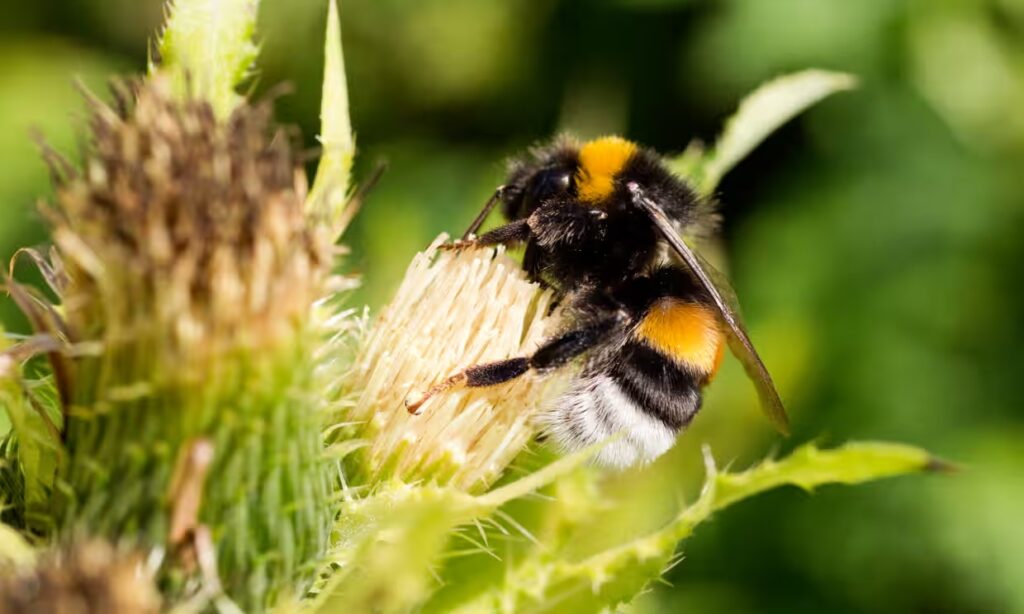Bumblebees and Hornets Collide with Impact, Forcing Aggressor to Flee, Discovered by Researchers at the University of Exeter
Bumblebees, known for their industrious buzzing and vital role in pollination, find themselves facing an unlikely adversary: the Asian hornet. These hornets, swift and formidable in flight, pose a significant threat to the less agile and slower-moving bumblebees. The scenario of an airborne clash between the two would seemingly tip the scales in favor of the hornets, known for their persistence and lethal attacks.
However, in a surprising revelation, scientists from the University of Exeter have uncovered a fascinating and effective defense mechanism employed by buff-tailed bumblebees when confronted by Asian hornets. Rather than engaging in a futile aerial skirmish, the bumblebees resort to a seemingly counterintuitive strategy—they drop from the sky “like a brick.”
Thomas O’Shea-Wheller, from the Environment and Sustainability Institute on Exeter’s Penryn campus in Cornwall, and his colleagues made this intriguing discovery during their fieldwork in Galicia, northwest Spain. The researchers were not only impressed but also found a touch of amusement in observing the bumblebees’ unique behavior.
In the heat of an attack, the buff-tailed bumblebees execute a sudden free-fall, descending rapidly to the ground. The impact upon landing is substantial, often dislodging the hornet or providing the bumblebee with an opportunity to retaliate by raising its stinger and forcing the attacker to retreat.
O’Shea-Wheller described the action vividly, stating, “The second the hornet grabs on to or clashes with the bee in the air, the bumblebee drops like a brick straight on to the ground.” This unanticipated strategy has proven effective, serving as a swift and gravity-fueled deterrent against the persistent hornets.
The researchers speculate that the bumblebees’ confidence in employing this strategy might be linked to their habit of nesting underground. The abrupt descent to the ground becomes a calculated move to evade the hornet and utilize gravity as an ally in their defense.
Despite the successful nature of these airborne evasive tactics witnessed in over 120 attacks, the story takes a nuanced turn. The scientists, who detailed their findings in the journal Communications Biology, reveal a less optimistic side for the bumblebee colonies in regions with high Asian hornet populations.
While the bumblebees successfully repelled direct attacks at colony entrances, colonies in these high-risk areas experienced reduced growth rates. This suggests that, despite the individual victories, the continuous presence of Asian hornets has broader implications for the overall success and expansion of bumblebee colonies.
O’Shea-Wheller raises thought-provoking questions about the intricate relationship between these two species. Could there be external factors favoring Asian hornets that inadvertently harm bumblebees? The study prompts a deeper exploration into the complex dynamics of these interactions within ecosystems.
As sightings of Asian hornets reach record levels in the UK, the concerns for native pollinators, particularly bees, intensify. The delicate dance between buff-tailed bumblebees and Asian hornets serves as a poignant reminder of the challenges faced by pollinators in the ever-evolving landscapes impacted by invasive species.
Masterful Survival: Five Animals with Extraordinary Tactics to Elude Predators
- Giant Cuttlefish: Masters of Disguise
- Similar to chameleons, these cephalopods can change the color of their skin to seamlessly blend into their surroundings. Going beyond, they possess muscles to alter their physical texture, transforming from smooth-skinned creatures to resembling strands of seaweed. Males even mimic females to avoid confrontations.
- Kangaroo Rat: Acrobat of the Desert
- In the challenging landscapes of the south-western US deserts, the kangaroo rat faces the constant threat of sidewinder rattlesnakes. Their remarkable reactions allow them to leap out of harm’s way within a fraction of a second. Armed with karate-style kicks, they can flick away snakes that get too close.
- Pufferfish: Size-Shifting Strategists
- Employing a tactic seen across the animal kingdom, pufferfish can inflate themselves several times their normal size by filling their stomachs with water. This impressive size shift is a visual deterrent, making them appear larger to potential aggressors.
- Regal Horned Lizard: Desert Artillery
- Adapting to a slower pace, this desert dweller deploys unique self-defense mechanisms. Capable of shooting blood from its eyes, the lizard can deter hungry coyotes with a range of about 1 meter (3 feet). It also exhibits color-changing abilities and can inflate itself with air, akin to the strategy of a pufferfish.
- Opossum: The Art of Playing Dead
- Among the animals that employ thanatosis, or tonic immobility, opossums take a theatrical approach. When threatened, they dramatically throw themselves onto their backs, bare their teeth, drool saliva, and release a foul-smelling liquid from their anal glands—an elaborate performance to deceive and deter predators.
Discover the diverse and fascinating world of these creatures, each showcasing unparalleled adaptations for survival in the wild.
